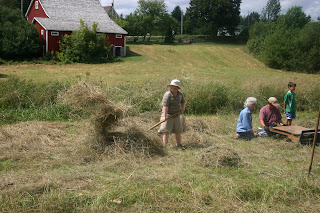Apologies for the lack of posts lately, although there isn't much exciting news coming from the garden this time of year there are still lots of projects on the go. Now that the harvest is all in I've been tallying the crop and writing the 2010 seed catalogue, I hope to have it up on the website in November. I have about 5 times last year's quantities and twice the number of varieties available (with many more grown in small amounts on track for the 2011 catalogue).
Aside from the seed work I'm beginning to focus once again on the forest, I'm working to remove the conifer seedlings from a two acre logged area so to encourage the growth of mixed hardwoods in this patch. The plan is to manage the hardwoods as a coppice, that is cut on a regular and continueous cycle of harvesting and regrowth. The trees send out many new shoots from the stump and when cut as 10 or 15 year old poles they aren't injured. Indeed they can have their life spans greatly increased, basically by being kept in a state of continueous youth. What's most appealing to me is that it's a style of forestry totally human scaled, the trees are cut at a size where they're managable without any machinery, all that's needed for harvesting and working are a few basic hand tools (billhook, machete, axe, bow saw, froe...). This regular cutting creates an interesting symbiosis between the coppice ecosystem and humans. I sometimes think of it as similar to mowing a wild meadow of grasses and wildflowers, both the coppice and the meadow can be cut in a human scaled and sensitive way to provide for us without damaging the ecology of the site.
I also want to mention the new community garden being set up in Middleton. There's been talk going on for a little while but the town council is now on board and we're in the process of selecting and clearing a site. I've been informally appointed the lead garden consultant for the project, the other day I checked out the four proposed sites with the others involved and we all agreed on the old field next to the ice rink (you need to be from Middleton!). It's a central location in town with fertile clay-loam soil and there's a path along side that connects to Main Street. I can invision a sign and an arbour directing people to the bountiful eden behind the trees. That's still a ways away though, we're hoping to get it cleared and plowed before the ground freezes so we can get everyone planting next spring.
Today was the International Day of Climate Action (
www.350.org) and in observance I mowed a second "350" in the wet, soggy clover. The rain was too heavy to get photos so I'll post a photo and a better write-up in a day or two...




















































